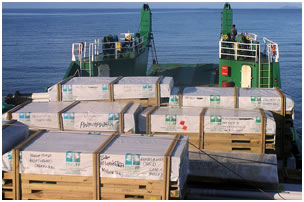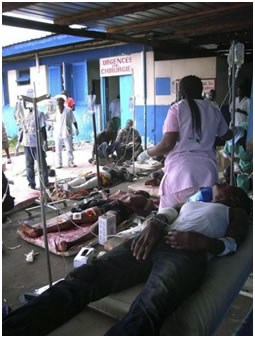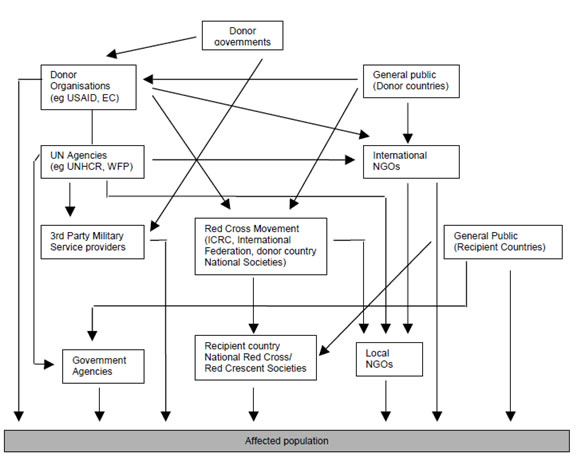Topic 5: Aid organistions
The role of international humanitarian assistance
Humanitarian assistance is a term that is commonly applied to the delivery of international aid to populations affected by natural disasters and wars. It is sometimes used interchangeably with the terms ‘emergency assistance’ or ‘emergency aid’. However, ‘emergency assistance’ or ‘emergency aid’ are more narrowly focused concepts, and do not necessarily incorporate the widely recognised humanitarian principles of impartiality, universality, political neutrality and protection of vulnerable populations.
Agencies normally providing human assistance include: the Red Cross Movement, various United Nations agencies and a large (and ever growing) number of non-governmental organisations (NGOs). If these NGO’s are operating outside of their own country they may be referred to INGO’s, the ‘I’ standing for International.
The United Nations agencies involved in humanitarian assistance include:
UNHCR (the Office of the United Nations High Commissioner for Refugees) http://unhcr.org.au/unhcr/
UNICEF (the United Nations Children’s Agency) http://www.unhcr.org/cgibin/texis/vtx/page?page=4a2d04036/
WFP (the World Food Programme) http://www.wfp.org/
UNDP (United Nations Development Programme) http://www.undp.org/
The UN system also aims to assist in the coordination of the humanitarian assistance operations of its own agencies, the Red Cross and NGOs through UNOCHA, which is the UN Organisation for the Coordination of Humanitarian Affairs.
Certain UN agencies may run their own operations on the ground in some emergencies, but much of the humanitarian assistance funding that passes through UN agencies is channelled to NGOs, which are sub-contracted as local implementing partners. In most humanitarian emergency situations there are scores of international NGOs. Some of these have quite a long history and, like the Red Cross, were established in response to the suffering of people caught up in wars.
Humanitarian assistance funds are partly provided by the philanthropic and charitable donations of individuals, private companies, solidarity groups and religious organisations. Public concern about a particular event (such as the Asian tsunami in 2004) can result in very large ‘ear-marked’ contributions. Most donations of these kinds go to NGOs, however, for the majority of years most humanitarian assistance funds come from official aid programs. Official aid programs provide humanitarian aid through NGOs, the UN and often the governments of affected regions (as well as occasionally though rebel groups). In addition, they may run their own relief operations, or jointly finance the emergency programs of multilateral agencies, such as the European Union.
The complexity of the international system for responding to complex emergencies cannot be overstressed. Figure 5.1 conveys some of the complexity by showing the principle routes of resource flows within the system. The organisations commonly involved in the provision of humanitarian assistance include national relief structures (local NGOs, UN agencies, international NGOs, the ICRC, the IFRC and the national Red Cross and Red Crescent Society).
Figure 5.1: The International Relief System (Borton, 1997) |
In some instances large bilateral and multilateral donor organisations may establish local field teams with the objective of funding locally prepared projects and coordinating their overall activities. Diplomatic activity by neighbouring states, powerful states and others seeking to achieve either a cessation of the conflict or prevent its escalation, is a common feature of many complex emergencies.
Human rights agencies and monitors and organisations seeking to resolve the conflict are increasingly active in areas of ongoing conflicts. In those situations where international peacekeeping or peace enforcement forces are deployed either by the UN or by regional bodies [e.g. North Atlantic Treaty Organisation (NATO), Organisation of African Unity (OAU), Economic Community Of West African States (ECOWAS), Commonwealth of Independent States (CIS)] humanitarian activities will run in parallel to, or in concert with, the peacekeeping operations. Such military interventions may involve troop contingents from a variety of countries. In situations where displaced populations cross international borders, refugee agencies will become involved together with the governments of the asylum countries.
It is not uncommon for neighbouring states to be involved (either overtly or covertly) in intra-state conflicts in neighbouring countries. States with traditionally strong links with the conflict-affected country or which perceive their strategic interests to be at stake may also play a role in relation to the conflict.

Flat-packed classrooms on route to schools across PNG.
The pack up and go design means they can be easily loaded onto a ship and carried into the most remote regions on foot.
Source:Stanley Oluwond/AusAID, http://www.ausaid.gov.au/hottopics/topic.cfm?
ID=8934_9123_9929_3384_837&From=HT
A typical complex emergency may therefore involve the following organisations: seven to eight UN agencies; the Red Cross Movement (ICRC, IFRC and the National Society); fifty or more international and local NGOs involved in the provision of humanitarian assistance, human rights activities and conflict-resolution activities; military contingents operating either under a UN or a regional organisation mandate; and agencies controlled by or associated with the warring factions. The range of security and humanitarian activities may be funded by twenty or more official donors supplemented by funds raised privately. In addition, a number of neighbouring and powerful states may be taking a keen interest in the course of the conflict and possibly seeking to influence the outcome by overt or covert means. Given that central authority structures are generally weak or absent, co-ordination of such a multiplicity of actors becomes a major challenge - one that has not yet been fully met by the international humanitarian system. Coordination structures and mechanisms which exist within the UN system and the NGO community are rarely strong and effective. Furthermore, the wide range of actors involved in the response, or with an interest in the outcome of the conflict, almost guarantees that their goals will not be shared and may even be at odds with each other.
The response to a complex emergency is not limited to multi lateral modalities such as through the United Nations. In some cases, early intervention is characterised by bilateral support, where a donor government is compelled to provide immediate assistance due to its close diplomatic and/or historical relationship with a recipient country. More often than not, these bilateral actions are undertaken through accredited non government organisations operating in the affected country prior to the escalation of the crises. This is practiced, for example, by the US Government, the European Commission and in Australia by AusAID.
Regardless whether through multi lateral or bilateral means, accredited NGOs are expected to adhere to the policy of the donor government, which is not without criticism in complex emergencies where opposing parties may suspect the political motives behind NGO presence within their locality. This is problematic as due to this perception, many NGO workers are increasingly becoming victims of violence themselves.
AusAID expects its partner NGOs to conform with their Humanitarian Policy. AusAID sees the need for NGOs to be eligible for funding and the accreditation process aims to provide AusAID, and the Australian public, with confidence that the Australian Government is funding professional, well managed, community-based organisations that are capable of delivering quality development outcomes. Although NGOs are independent in governance, it is inevitable that the donor policy will determine how their resources will be used. In the context of AusAID’s policy, there is a lot of room for humanitarian action which
includes not only protection and material assistance but also capacity building, vulnerability reduction, the promotion of disaster and emergency prevention and preparedness measures. The policy has a particular focus on increased participation by beneficiary governments and communities in all levels of activities.
AusAID website: http://www.ausaid.gov.au/about/default.cfm

In Abidjan, Médecins Sans Frontières has set up Emergency support in collaboration with the Ministry of Health in Abobo South Hospital.
Médecins Sans Frontières (MSF), or Doctors Without Borders
Médecins Sans Frontières :
“Some NGOs value the “independent and neutral” tag more than others. An example is the Médecins Sans Frontières (MSF), or Doctors Without Borders, which is a secular humanitarian-aid non-governmental organisation best known for its projects in war-torn regions and developing countries facing endemic diseases. MSF was created in 1971 by a small group of French doctors and journalists in the aftermath of the Biafra secession, who believed that all people have the right to medical care regardless of race, religion, creed or political affiliation, and that the needs of these people outweigh respect for national borders. The organisation actively provides health care and medical training to populations in about 70 countries, and frequently insists on political responsibility in conflict zones. In order to be able to speak and act freely, MSF remains independent of any political, religious or economic powers. The majority of MSF activities are paid for with private donations.”
Interactive game http://www.msf.org.au/rciyw/
